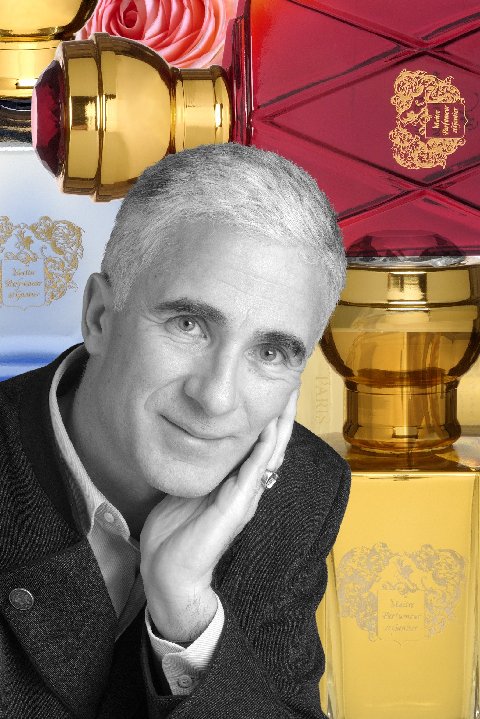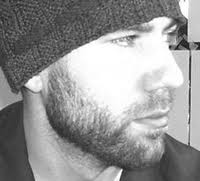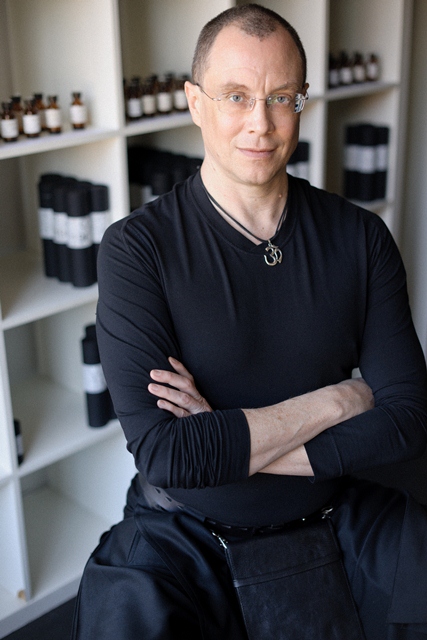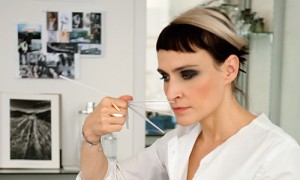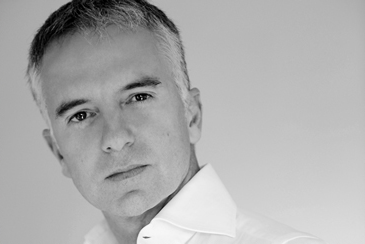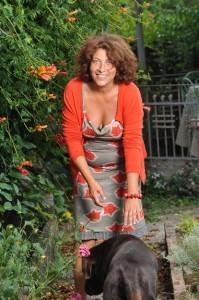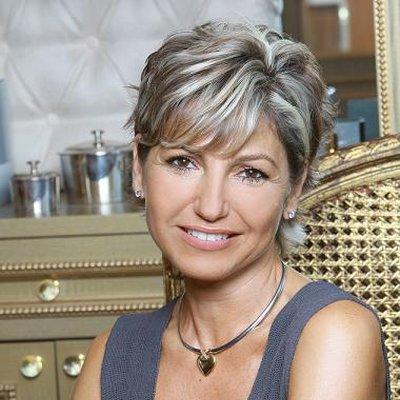Schimmel, Dragoco, Firmenich, Givaudan - a century of research
Scent & Chemistry - The Molecular world of Odors
plus two special perfumes in my collection
By Octavian Coifan
Monday morning on a heavy rain I was with Yann Vasnier in his office. My
eyes were mesmerized by a tiny bottle labeled "Wizard". I had in my
mind a perfume I call Belladonna because it is inspired by Monica
Bellucci and Florentine perfume secrets I studied. In the past I wrote
an article about the old label used for perfume ingredients -
The Alchemist engraving - in 2012 it's about a special type of science - the chemistry of perfumes and the alchemy of beauty.
Dr. Philip Kraft is one of the authors of Scent & Chemistry, the new
updated version of Günther Ohloff's classic opus I presented yesterday,
and an inventor of many modern jewels. He designs new captive odorants
for use in fragrances like the special musks used by Daniela Andrier in
her amazing Prada perfumes. Serenolide is on everybody in Paris this
season, it is also the case for the amazing Azurone I've discovered for
the first time inside the highly original "Secretions Magnifique" and
the daring "Bloom", one of the most unusual marine flowers in my
collection. The new style for masculine perfumes in Paris, deep woody
oriental with new original notes, often signed by Olivier Pescheux, is
based on several powerful scented jewels he designed.
Dr. Philip Kraft joined Givaudan research in 1996, he has authored 78
publications and 27 patents and invented Super Muguet, Azurone,
Pomarose, Serenolide, Cassyrane, Sylkolide. The musk "DNA" can be
considered his specialty and from his lab in Swizerland emerged the new
generation of musks which are shaping the style of modern creations
because everything starts with the amber and the musk you put in a
fragrance. He is also a perfume lover and connoisseur, one of the
authors who unveiled the secrets of Rallet and Chanel in Perfume &
Flavorist, one of the first articles where history is combined with
perfume analysis. Dr. Philip Kraft co-organized the Flavor &
Fragrance conference series of the Royal Society of Chemistry and the
Society of the Chemical Industry in Manchester 2004 and London 2007 (
Current Topics in Flavor and Fragrance Research
and
Perspectives in Flavor and Fragrance Research
).
Among his well known papers/books are “Fragrance Chemistry“, “Odds and
Trends: Recent Developments in the Chemistry of Odorants”, “New and
Unusual Natural Products of Fascinating Flower Scents“, and a book
chapter on “Musks”.
Now, Dr. Philip Kraft continues the legacy of Günther Ohloff
and Wilhelm Pickenhagen and updates the Bible of the fragrance
chemistry,
Scent and Chemistry: The Molecular World of Odors, a magnum opus in 2012.
1. What do you consider as the most beautiful, original molecules or elegant synthesis of the past 5-10 years?
Philip Kraft: It's really very difficult to say which new
odorants launched most recently will turn out most influential. Such
statements are obviously best done in retrospective as only time can
tell. For that reason Fig. 1.4 stops in the 1990s with 'Galaxolide' and
'Trésor' (Lancôme, 1990), 'Calone 1951' and 'Kenzo pour homme' (Kenzo,
1991), as well as ethyl maltol and 'Angel' (Thierry Mugler, 1992). Yet,
just as dihydromyrcenol became the "new lavender", I think of
undecavertol by Dietmar Lamparsky and Roman Kaiser as a new trendsetter
in the green leafy direction, certainly so since 'Be Delicious' (DKNY,
2004) by Maurice Roucel appeared on the market. Symrise's 'Ambrocenide'
(8.141) by my co-author Wilhelm Pickenhagen and Dietmar Schatkowski
initiated a new trend towards high-impact ambergris materials such as
Belambre (8.142), Trisamber (8.143), Ambermax (8.145) etc. that led to
powerful dry (almost dusty, isopropanol-type) ambergris notes; and
Helvetolide (8.97), discovered by Ohloff's former co-workers Wolfgang
Girsch and Karl-Heinz Schulte-Elte, keyed the white musk trend that led
to 'Romandolide' (8.98), 'Serenolide' (8.99), 'Sylkolide' (8.100), and
'Apelide' (8.101), revolutionizing so many musk accords since. My own
personal favorite is 'Pomarose' (6.80), which is also shown on the
cover, superimposed on beta-damascenone. It introduced the dried-fruits
note into masculine perfumery with its debut at 0.36% in 'Be Delicious
Men' (DKNY, 2005) by Olivier Gillotin and Pierre Negrin. Then soon
afterwards Pomarose saw its first overdose in 'Unforgivable' (Sean John,
2006), and set against a blond leather accord is essential in '1
Million' (Paco Rabanne, 2008) by Christophe Raynaud, Olivier Pescheux,
and Michel Girard. In fact, '1 Million' is now copied so intensively
that it becomes a trendsetter on its own, almost like 'Fougère Royale'
and 'Chypre de Coty' did back then, or 'Fahrenheit' now ... yet,
Pomarose brought also interesting new effects to other families, such as
that of aromatic fougères with 'CK free' (Calvin Klein, 2009) by Ellen
Molner and Rodrigo Flores-Roux, the aldehydic 'hair-spray' rose of 'John
Galliano' (John Galliano, 2008) by Aurelien Guichard and Christine
Nagel, and contrasted by Evernyl (7.488) in Olivier Pescheux's 'Legend'
(Montblanc, 2011), currently my most favorite perfume.
2. Chemistry is often misunderstood by consumers as a cheap
replacement, but looking on RM price lists, it is not necessarily the
case. What are the molecules which could be considered today as Haute
Couture ingredients by their price or power?
Philip Kraft: I consider most of the captive molecules in every
company as 'Haute Couture' ingredients today. Their syntheses are not
yet optimized over decades by many synthetic chemists of competing
companies, such as has happened for instance in the case of Hedione over
the past 50 years. So captives generally need to make up their
comparatively high price by a much better performance. You can get most
citrus oils, even a less refined orange flower oil, below $30, while
Ambroxan is still positioned well above $1000, as is the case for
damascenone, for instance. There are special high-price grades of
essential oils, but likewise we now have special grades of 'Hedione',
from 'Kharismal' to 'Hedione HighCis' to 'Paradisone', or from
'Timberol' to 'Nimberol' to 'Dextro-Norlimbanol'. Synthetic raw
materials are so useful since they allow a higher degree of freedom in
perfumery composition. A perfumer can build his own signature rose,
while otherwise he is limited by the palette of natural rose oils. He
even can create a true headspace --the real smell of a flower bud--
rather than what is left after distillation of the plant material, and
he can create scents of flowers that do not yield an essential oil. So
chemistry opened up artistic freedom of perfumery, and that is the
critical price criterion.
3. Several years ago I was invited to discover the extractions of
rose absolute and jasmine at Chanel, but chemical synthesis can produce
even more potent scents during the manufacture process in a lab or in a
factory. What are the most unforgettable experiences for an organic
chemist?
Philip Kraft: End of 1996, Katja Schultz and myself (J. Essent.
Oil Res. 1997, 9, 509--514) distilled some large quantities of Angelica
root oil to investigate its macrolide fraction, and those very last,
high-boiling fractions we isolated had a truly unforgettable, extremely
lovely musky scent. This scent is still in my mind, and is amazingly
close to the recently launched '(untitled)' (Maison Martin Margiela,
2010) with its 0.3% galbanum and its 17% of 'Serenolide'. In the
discovery of Pomarose we were chasing a minor impurity, the NMR of which
then gave the inspiration to synthesize a structural isomer, that
finally even had superior olfactory properties and became 'Pomarose'.
Also in the discovery of the patchouli ketol 7.171 (p. 255), we were
chasing a powerful impurity that initially spoiled the olfactory purity
of a woody-ambergris odorant. These truly were unforgettable experiences
as well.
4. Perfumers do not often wear a fragrance when they work. Do you
wear a fragrance when you work? What perfumes do you enjoy to wear or to
smell around you?
Philip Kraft: I do wear perfumes most of the time, and in a lab
there are generally many sorts of smells and solvent notes, so it is not
too much of a problem. I usually wear it on the arms only, often one
per arm, and more subtly in the morning, so that it does not interfere
with a pre-evaluation of the freshly synthesized odorants, which anyway
are more potent. Today I wear 'Amber Soie' (Armani/Privé, 2004) by
Christine Nagel layered 2:1 with Sophia Grojsman's '100% Love'
(S-perfumes, 2003). I do have a big collection of scents in my lab,
which I also use for my lectures, but my desk at home is even more
crowded with flacons, new launches, own composition, demo formulas.
After work I can wear them more generously, but even at work, I often
take out a flacon to distress, to focus or simply enjoy a certain smell
or odor note.
If I would have to give a current spring-time top 10, it would probably look like this:
1. 'Legend' (Montblanc, 2011) by Olivier Pescheux;
2. 'the One Sport' (Dolce & Gabbana, 2012) by Nathalie Gracia-Cetto and Guillaume Flavigny;
3. 'Artisan' (John Varvatos, 2009) by Rodrigo Flores-Roux;
4. 'Egoïste' (Chanel, 1990) by Jacques Polge;
5. 'CK free' (Calvin Klein, 2009) by Ellen Molner and Rodrigo Flores-Roux;
6. 'Unforgivable' (Sean John, 2006) by Dave Apel, Pierre Negrin, Caroline Sabas, and Aurelien Guichard;
7. 'gs01' (Biehl Parfümkunstwerke, 2009) by Geza Schoen;
8. 'Escentric 02' (escentric molecules, 2008) by Geza Schoen;
9. 'Wonderwood' (Comme des Garcons, 2010) by Antoine Lee;
10. 'Eau Radieuse' (Humiecki & Graef, 2008) by Christophe Laudamiel.
But I also love the complete 'L'Oeuvre Noir' scents by Kilian, and
layering fruity female scents like 'Oh Lola!' (Marc Jacobs, 2011) by
Calice Becker and Yann Vasnier on dark woody masculine ones such as
'Polo Double Black' (Ralph Lauren, 2006) by Ellen Molner. Wearing
perfumes always inspires to work on certain notes, or certain odor
aspects, so it is even more than only fun. A lot of fun and inspiration
is compounding with your own products, as is getting demos from others
with your most recent new odorant molecules. For instance, I just
received a very excellent demo from Alain Alchenberger called 'Nemesis'
for one of my most recently designed new high-impact odorants.
5. Perfumers have to learn an impressive number of ingredients before
they start creating, but chemists usually create a big number of
molecules before a selection is made. I did not count their number in
C&S book, but do you know how many different molecules have you
smelt since you began making them?
Philip Kraft: Well, fragrance chemists have to learn all the
perfumery benchmarks as well, and they best know all the ingredients a
perfumer knows as well. When working on a certain family, you will soon
know in fact many more materials. For instance when working on musks, we
have synthesized certainly around 1000 different musks alone, which is
almost as if the whole composition palette of a perfumer would
constitute of musks only. The numbers of different molecules I made and
smelled are immense, but of course we smell also the molecules of our
colleagues. Therefore, it is really impossible to give any precise
numbers.
6. More than one hundred years ago, the orris notes and flower
absolutes, then musk, amber secrets and the rose … all delivered their
key notes and became available generating new perfumes. What is today
the Holy Grail of research?
Philip Kraft: There are several Holy Grails of Fragrance
Chemistry: The 'next Hedione', a readily biodegradable, new and
transparent neo-'Iso E Super', the 'best-ever' musk, the first synthetic
commercial vetiver odorant, the first commercial synthetic patchouli
odorant, the most potent orris odorant ever, a completely unprecedented
new odor note, a new floral odorant of an 'unknown flower', the most
radiant muguet ever, the possibilities are absolutely endless, and each
single one of them constitutes such a fundamental breakthrough that it
would revolutionize perfumery. We will surely see much more in the not
too distant future. The current market needs new signatures, and these
have to come from 'new molecules', and also environmental and
toxicological issues bring about new Holy Grails.
7. Marine notes did not exist in a lab several decades ago. Are there
scent territories yet to be discovered and what do you consider as a
the future of scent and chemistry?
Philip Kraft: It is quite impossible to predict where trends will
go. 'Azurone' for instance was initially developed for fine fragrances
only, but is now much more sought after by wash and detergent perfumers.
At that time, nobody expected people would like a marine note creeping
out of a washing machine, and that's not even 10 years ago: There is
always a new freshness, a new way to seduce, simply because the old
fresh no longer is fresh anymore, or a stereotypical seduction no longer
works out ... scent and chemistry is certainly a matter of fashion.
8. In the enchanted forest of perfume ingredient some "flowers" might
get lost. Are there modern ingredients from Givaudan (or other
companies) which are not enough known and could be used to bring a
stronger signature to perfumes or body products?
Philip Kraft: For sure, there are undiscovered treasures already
in the Cardex (Givaudan), the Blue Book (Firmenich), or whatever the raw
material inventory is called. 'Calone 1951' and undecavertol were
around a long time before they became trendy. Maltol and ethyl maltol
even longer. Yet, it requires the right brief, a daring and
experimenting perfumer, who knows all the available materials of his
palette, and a customer determined to go for the new and unusual. It is
true that this might get more difficult with all the rush and time
pressure, and consequently, the limited amount of time a perfumer can
now focus on a brief. On the other hand the vast market requires
signature and novelty, and we really did see a lot of exciting new
fragrance launches, e.g. Christophe Raynaud's 'Decibel' (Azzaro, 2011)
with a very prominent licorice note. It might however take a while till
the market goes totally crazy for licorice, and since a few
licorice-smelling odorants are existing, before a lovely
licorice-magnolia-musk odorant I discovered years ago, and which a
perfumery student girl ludicrously termed 'Kraftolide', will have a
chance to jump in on that trend -- and extend it even further. However,
perhaps 'Mystical' (7.514) byJean-Pierre Bachmann and Felix Flachsmann
can now initiate an incense rush, as after major gourmand and marine
trends, incense notes are already on the rise for some time, and now
even outside the niche brands. Antoine Maisondieu's '7 de Loewe' (Loewe,
2010) may have shown a way into the future here already.

